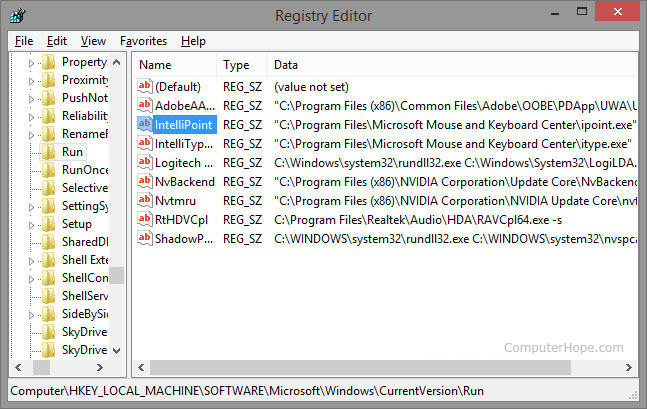How To Open Registry Editor Windows 7
How exercise I open and edit the Windows registry?
Updated: 12/05/2021 past Computer Hope
Fixing Windows errors, tweaking Windows features, or completely removing a program can sometimes require you to edit the Windows registry. This page provides help with opening and viewing the Windows registry, editing, and deleting registry values.
How to open the Windows registry
To open the Windows registry, follow the steps below for your version of Windows.
Note
If y'all have restricted access to the Windows reckoner yous're logged in to, you may not be able to access the Windows registry.
Windows xi
- On the Windows taskbar, click the magnifying glass icon.

- In the text field at the top of the search window, blazon regedit and printing Enter.
- If prompted by User Account Control, click Yes to open the Registry Editor.
- The Windows Registry Editor window should open and look similar to the case shown below.

Windows 10
- Blazon regedit in the Windows search box on the taskbar and press Enter.
- If prompted past User Account Command, click Yes to open up the Registry Editor.
- The Windows Registry Editor window should open and look similar to the example shown below.

Windows viii
- Type regedit on the Beginning screen and select the regedit pick in the search results.
- If prompted by User Account Control, click Yes to open the Registry Editor.
- The Windows Registry Editor window should open and look similar to the case shown below.

Windows 7 and earlier
- Click Get-go or printing the Windows cardinal.
- In the Start menu, either in the Run box or the Search box, type regedit and printing Enter. In Windows 8, you tin blazon regedit on the Start screen and select the regedit option in the search results. In Windows 10, type regedit in the Search box on the taskbar and press Enter.
- If prompted past User Account Control, click Yep to open the Registry Editor.
- The Windows Registry Editor window should open and look similar to the case shown below.

How to browse the Windows registry
When well-nigh users edit their registry, they're given the location or path of where the registry value is located and what to alter. Beneath is an case path for a commonly accessed registry subkey. To scan this location, you lot commencement showtime by opening the HKEY_LOCAL_MACHINE primal (folder). In this key, you run across the SOFTWARE binder, then Microsoft, Windows, CurrentVersion, and finally the Run folder.
HKEY_LOCAL_MACHINE\SOFTWARE\Microsoft\Windows\CurrentVersion\Run
Tip
Each backslash ("\") in a registry path represents another binder in the registry, with the name of that folder following the backslash.
After navigating to the registry path higher up, yous see a window similar to the example below. In this example, you lot can see four different cord value keys, which point to the programs that run each time the reckoner is turned on or restarted.

How to edit a Windows registry value
To edit a registry value, double-click the name of the value yous desire to edit. For example, if we double-click the 'IntelliPoint' value in the example in a higher place, a new window appears that would permit us to change the data value. In this instance, nosotros could modify the file path of where the "ipoint.exe" file is located for the IntelliPoint driver.
How to delete a Windows registry value
To delete a registry value, highlight any registry Name and printing the Del key on the keyboard. For example, if we did not want the IntelliPoint program to load each time Windows starts, nosotros could highlight IntelliPoint and press Del.
Windows registry shorthand and abbreviations
In some documentation and online forums, the registry values may be abbreviated. For example, instead of saying "HKEY_LOCAL_MACHINE," it is easier to say and write "HKLM." For a listing of registry terms and shorthand, run across our registry definition.
How To Open Registry Editor Windows 7,
Source: https://www.computerhope.com/issues/ch001348.htm
Posted by: chavisiont1981.blogspot.com


0 Response to "How To Open Registry Editor Windows 7"
Post a Comment